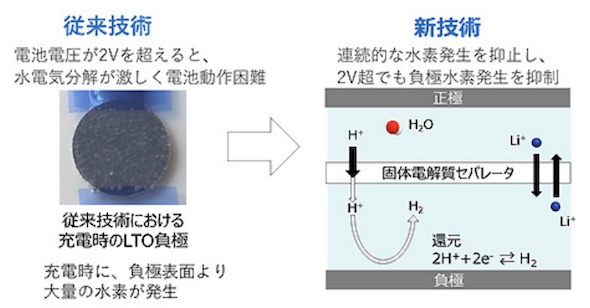
東芝:“燃えない”LiBを開発:Aqueous Lithium-ion Battery(動画):
Toshiba: Newly developed “non-burning” LiB: Aqueous Lithium-ion Battery:
东芝:新开发的“非燃烧”锂电池:锂离子水溶液
ー低コスト化の実現もー
東芝:
2020年11月19日
「マイナス30℃でも運用できる水系リチウムイオン二次電池(以下、水系電池)」を、世界で初めて開発したと発表した。
電解液に水を用いる電池で、外部要因で火災が起きた際にも安全なのが特徴だという。
今後早期のサンプル提案を目指す。
再生可能エネルギーの普及:
太陽光発電など、再生可能エネルギーの普及拡大に伴い、天候に左右される出力変動を吸収するため、蓄電池の需要が高まっている。
リチウムイオン二次電池:
蓄電池には、リチウムイオン二次電池が採用されるケースが多い。
しかし、3.7V以上の高い電圧を維持する必要がある。
その為、一般的に、電解液には可燃性有機溶媒が、利用されている。
水系リチウムイオン二次電池:
今回東芝が開発した水系リチウムイオン二次電池。
負極には、「黒鉛ではなく、燃えないリチウムチタン酸化物(LTO)」を採用している。。
- 加えて、安全性をより高めるため、
- 外部要因で火災が起きた際の安全性にも考慮し、
- 電解液に、不燃性水溶液を採用した。
従来の水系電池:
これまでの水系電池は、「長期間運用すると、水溶液の電気分解反応」が進行する。
そのため、「充放電反応が進まないこと」が難点だった。
東芝の水系電池:
東芝は、「リチウム塩の濃度が高い高濃度電解液」と「固体電解質セパレーター」を組み合わせた独自の電池構造を開発。
「正極側から、負極側への水素イオンの移動を防ぐこと」で、水溶液の電気分解を抑制した。
その結果:
「従来技術の10倍となる約2000回以上の充放電を実現」
また、
「水系電池としては高い2.4Vの電圧も達成」
さらに、
低温でも凍らない水溶液を使って、「マイナス30℃でも充放電が可能」となった。
利用分野:
- 可燃物を含まず、消防法の危険物に該当しない、
- 安全対策を従来よりも、簡略化できる、
- また、設置場所制限も緩和されるため、
住居近くや、オフィスビル内にも設置できる。
電解液に水を使うことで、「製造設備の簡略化による低コスト化」も期待できる。
スマートジャパン
https://www.itmedia.co.jp/smartjapan/articles/2011/20/news067.html
Toshiba Develops World’s First Aqueous Lithium-ion Battery with Nonflammable Electrolyte
-Greater freedom in locating large-scale stationary energy storage systems expected to contribute to stable management of renewable energy sources and realization of a decarbonized society-
November 19, 2020
Toshiba Corporation (TOKYO: 6502)
has developed a prototype aqueous rechargeable lithium-ion battery
that points the way to realization of the world’s first aqueous large-capacity stationary storage battery that can operate at -30°C.
Countering climate change and reducing greenhouse gas emissions
will require greater reliance on renewable energy sources that are characterized by intermittent availability, and maximized utilization will only be possible with management systems integrating storage batteries that are safe and reliable over the long-term.
Toshiba has addressed this concern by developing a battery cell that uses water as the aqueous electrolyte.
The battery demonstrates low risk over the long term, even in the event of exposure to fire, which expands the range of locations where it can be installed.
It also delivers the high durability of over 2,000 charge and discharge cycles, a performance that can contribute to expanded use of renewable energy.
Details of the technology
will be presented online at the 61st Battery Symposium in Japan on November 19, 2020.
The sun and wind are increasingly important renewable power generation sources worldwide, crucial for advancing de-carbonization.
However, unlike fossil fuel power sources, output from renewables fluctuates with the time of day, weather, season and location, and achieving a stable supply requires the deployment of large-scale stationary batteries to regulate output.
The batteries used in these systems
are lithium-ion rechargeable batteries (LIB), as they exhibit high energy density.
However, a major issue with LIB is safety. LIB achieves their high energy density by using a flammable organic solvent with a wide stable voltage window as the electrolyte.
This flammability often restricts where storage batteries ca be installed.
Guaranteeing high-level safety is a major concern because large-scale stationary storage batteries must be operated for a long period of time.
Toshiba’s SCiB™
achieves excellent safety performance by replacing the usual graphite anode with a nonflammable lithium titanate oxide (LTO).
Moving beyond this, the company has further boosted safety by developing a battery that uses an aqueous electrolyte.
While the LTO
secures the battery against shock and vibration, the aqueous electrolyte ensures safety in the event of a fire at the installation location.
This advance both simplifies the safety
measures necessary during installation, and broadens the scope of locations where systems can be installed.
It is now possible to consider installation near residential areas and inside office buildings, a factor that will contribute to more widespread use of large-scale storage batteries.
Toshiba Corporate Research & Development Center :